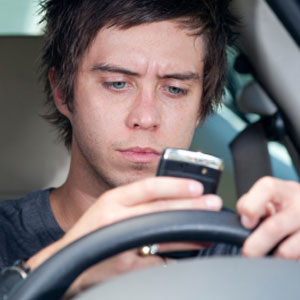
Teens with attention-deficit/hyperactivity disorder are worse drivers than their peers who don't have ADHD and texting only compounds their problems on the road, a new study shows.
What's more, texting behind the wheel is so distracting it makes normal teens drive as poorly as those who have ADHD, underscoring the danger to any driver of trying to text and operate a car at the same time, the researchers noted.
"Texting is on a different order of magnitude compared to other distractions. It's a concern for teens across the board, and kids with ADHD are at that much greater risk," said Dr Andrew Adesman, chief of developmental and behavioural paediatrics at Steven and Alexandra Cohen Children's Medical Center of New York, in New Hyde Park.
Adesman has studied the problem of texting and driving in teens, but was not involved in the current research. About half of teenagers admit to texting behind the wheel, according to a study published recently in the journal Pediatrics.
Driving simulator
About 6.4 million US children under age 18 have received a diagnosis of ADHD at some point in their lives, US health officials say. For the new study, published online on 12 August in the journal JAMA Pediatrics, researchers recruited 61 drivers who were 16 and 17 years old. About half of them had the disorder.
Kids with ADHD are frequently prescribed stimulant medication to control symptoms such as inattention and impulsivity. But since researchers say most teens drive at night and on the weekends, times when they are least likely to be medicated, the teen drivers were asked not to take the drugs.
All the teens operated a driving simulator for 40 minutes. For about half the time, researchers let them drive through urban and rural conditions without any distractions. For two 10-minute periods, they drove while talking on a cellphone or while texting with a researcher who was asking them questions from another room.
Texting and driving
Overall, teens with ADHD had significantly more trouble staying in their lanes and maintaining a constant speed than kids with normal attention. On average, they drifted out of their lanes 1.8% of the time.
Their driving records appeared to reflect these difficulties. About 17% of teens with ADHD had received at least one traffic ticket compared to 6 percent of those without the disorder.
And when they were asked to text, their driving problems nearly doubled. They strayed across the lane line or onto the shoulder about 3.3% of the time.
"That's just a heck of a lot of time for a kid or any driver to be out of their lane when they're driving," said study author Jeffery Epstein, director of the centre for ADHD at Cincinnati Children's Hospital Medical Center in Ohio.
The impairments of texting were evident for all drivers. When teens without ADHD were asked to text, they spent about 2% of their driving time creeping out of their lanes, which made their distraction as severe as those with an ADHD diagnosis.
"All the kids need to stop texting behind the wheel," Epstein said. "The impact of texting is just so big that for these kids to be texting behind the wheel just poses such a danger to themselves as well as other drivers that there just needs to be not only a policy of stopping texting behind the wheel but also enforcement," he said.
Parents play a big role in reining in the problem. Adesman recommends that parents print out and get teens to sign an online pledge, such as the one available from the US National Highway Traffic Safety Administration, and use it as a way to start a conversation about the problem.
Cellphone apps
Cellphone apps or easy-to-install devices for cars that will shut a phone off when they detect that the car is moving, Adesman said.
The attention troubles of ADHD are harder to tackle, but Epstein said he's testing behavioural interventions that he hopes will help.
"The deficit that kids with ADHD seem to have is that they tend to let their eyes look away from the roadway for longer glances than do experienced drivers," he explained.
Epstein said that eye-tracking systems that sound an alarm or cause the car seat to vibrate when drivers look away from traffic for longer than two seconds may help kids become more aware of the problem and help them self-correct.
"Those are the sorts of things that would be interesting if they work out," he said.
More information
The U.S. National Highway Traffic Safety Administration has more about teens and distracted driving.




 Publications
Publications
 Partners
Partners















